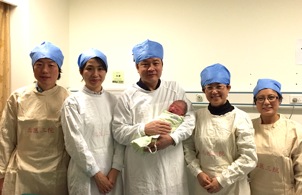The second baby with preimplantation genomic screening based on MALBC technique was born at the Peking University Third Hospital, Beijing, China, on November 30th of 2014. It brings new hopes to patients with monogenic diseases around the world that they can have a better chance to have healthy babies free from hereditary genetic disorders.
Two months ago, the first MALBAC baby was born at the same hospital. The baby’s father suffers from Hereditary Multiple Exostoses, a frame-shift point mutation at the EXT2 gene. The researchers analyzed all the embryos and picked one normal embryo free of both the point mutation and chromosome abnormality for transfer.
Different from the first case, the second case involves a mother who carries a heterozygous single base substitution at the exon8 of the EDA1 gene on the X chromosome, which results in X-linked hypohidrotic ectodermal dysplasia. The couple’s first son already shows symptoms of the family disease, including lack of hair, sweat glands, and teeth. They strongly desired to have another child to be free from this disease. Researchers at the Third Hospital and Biodynamic Optical Imaging Center of Peking University employed the MALBAC technique first developed by Sunney Xie’s lab of Harvard University. They sequenced the first and second polar bodies of each embryo in order to deduce which embryo is free from the disease allele as well as aneuploidy. After nine months of anxious waiting, the family welcomed their second child, who is healthy as expected.
There are about 7,000 known monogenic diseases, which are caused by one or one pair of mutated alleles, showing Mendelian inheritance patterns. Out of the 7000, the mutated genes of about 4,000 monogenic diseases have already been discovered. Although the rate for each single monogenic disease is pretty low, the total population that suffers from the diseases is very high due to the fact that there are so many different types of monogenic diseases. Most monogenic diseases show symptoms in infants and children, leading to death, disability or congenital malformation. Unfortuantely, only a few diseases can be treated effectively.
PGD (Pre-implantation genetic diagnosis) and PGS (preimplantation genomic screening) are techniques that help selecting normal embryos to transfer into the mother’s uterine using IVF. It is an early prenatal diagnosis technology.
Previously used PGD technologies include FISH (fluorescence in situ hybridization), PCR (polymerase chain reaction), Array-CGH (comparative genomic hybridization) and SNP-array (single-nucleotide polymorphism). These techniques are used to either detect specific point mutations or chromosome abnormality. However, they could not detect both at the same time. Peking University team was able to detect both aneuploidy and point mutations simultaneously with MALBAC method at low cost.
MALBAC, a powerful single cell whole genome amplification method, was first developed and reported by Xie’s lab in 2012. Unlike the traditional DOP-PCR and MDA, MALBAC uses quasi-linear instead of exponential amplification. More accurate and uniform, it can be used to analyze the genomes of rare and limited materials. At the end of 2013, Xie lab cooperated with Jie Qiao’s team and Fuchou Tang’s lab demonstrated the proof of principle of using MALBAC for polar bodies sequencing in IVF, which was published in Cell at the end of 2014 last year.
